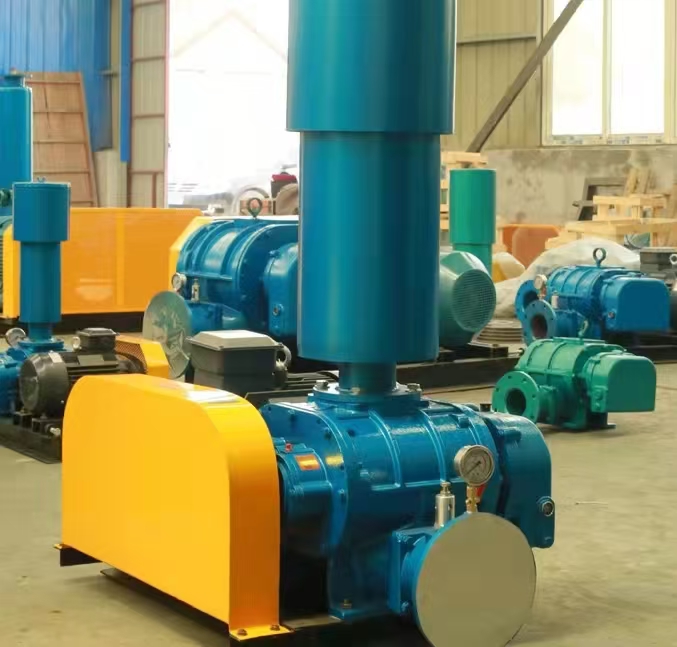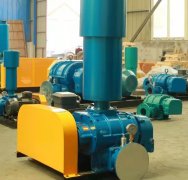Backwash Roots blower is a specialized equipment designed based on the principle of Roots blower, combined with backwashing technology, widely used in material conveying, gas treatment, and environmental engineering in the industrial field. The following introduces its working principle, technical characteristics, application scenarios, and selection points:
1、 Working principle
The recoil Roots blower uses two three bladed impellers to rotate in opposite directions inside the cylinder, forming a sealed chamber that pushes gas from the inlet to the outlet, achieving continuous gas delivery. Its core characteristics are:
1. Backwash function: During the exhaust process, the internal structure design or external pipeline control is used to intermittently flush the inside of the fan and the conveying pipeline with reverse airflow, preventing material blockage or scaling.
2. Forced air supply: When the impeller rotates, it forcefully compresses and delivers the gas to ensure stable and continuous air flow.
3. No internal compression: Gas does not undergo compression during transportation, only forming pressure at the exhaust port, suitable for low pressure and high flow conditions.
2、 Technical features
1. Energy saving:
Optimize impeller design for high volumetric efficiency and low energy consumption.
The three bladed impeller structure results in minimal airflow pulsation, smooth operation, and low vibration and noise.
2. Strong adaptability:
It can transport various gases such as clean air, coal gas, natural gas, etc., suitable for various working conditions.
The impeller and shaft are an integral structure, with no wear on the impeller and long-lasting performance.
3. Compact structure:
Small size, small footprint, easy to install and maintain.
The sealing structure has been optimized and designed to transport gases containing oil and grease.
4. Backwash function:
Prevent material blockage or scaling, and extend the service life of equipment.
Suitable for scenarios such as pneumatic conveying and dust treatment that require regular cleaning.
3、 Application scenarios
1. Environmental engineering:
Used for aeration oxygen supply and air backwashing filter media in wastewater treatment to improve treatment efficiency.
Dust removal, desulfurization, denitrification to reduce environmental pollution.
2. Material transportation:
Transport powdered and granular materials such as cement, flour, coal powder, etc.
Prevent pipeline blockage and ensure smooth transportation.
3. Chemical industry:
Used for gas transportation and pressurization, such as hydrogen, nitrogen, etc.
Cooperate with the wind knife installation, used to compress air and blow dry track moisture or substrate moisture.
4. Aquaculture:
Add oxygen to the aquaculture pond, increase the dissolved oxygen content in the water, and promote fish growth.
5. Incinerator manufacturing industry:
Supply air to reduce the black smoke generated during combustion and meet environmental standards.
4、 Key selection points
1. Airflow and pressure:
Determine the air volume and pressure parameters based on system requirements, and select the appropriate model.
For example, the pressure range of a 110kW Roots blower is 39.2-58.8 kPa, and the air volume range is 71.3-95.2 m3/min.
2. Medium characteristics:
Considering the temperature, humidity, corrosiveness, etc. of the transported gas, choose suitable materials and sealing forms.
For example, the return Roots blower is made of 20CrMnTi material, which has excellent casting quality and stable performance.
3. Environmental requirements:
Select the protection level based on the installation environment (such as temperature, humidity, dust, etc.).
Ensure that the temperature of the intake medium does not exceed 40 ℃ and the content of particulate impurities in the medium does not exceed 1000mg/m3.
4. Brand and after-sales service:
Choose well-known brands to ensure product quality and after-sales service.
For example, brands such as Changsheng have mature technology and stable quality.
5、 Maintenance and Precautions
1. Regular maintenance:
Check the bearings, lubricating oil in the oil tank, motor temperature, etc., and replace the lubricating oil in a timely manner.
Clean the muffler and air filter to prevent blockage.
2. Operation monitoring:
Pay close attention to the operation status of all components during operation, and open the bypass pipe for "ventilation" before stopping the machine.
3. Installation requirements:
Ensure that the fan is fixed on the ground to reduce vibration displacement during operation.
According to the different models of wind turbines, excavate pits on the ground according to size and embed foundation bolts.
6、 Typical application cases
1. A certain cement plant:
Use a recoil Roots blower for vertical kiln blowing to help materials fall vertically inside the kiln and achieve clinker firing.
2. A certain sewage treatment plant:
Adopting a backwash Roots blower for aeration and oxygen supply, as well as backwashing of filter materials, to improve the efficiency of wastewater treatment.
3. A certain chemical enterprise:
Use a recoil Roots blower to transport hydrogen gas, and install a blower to dry the substrate moisture to ensure production quality.



